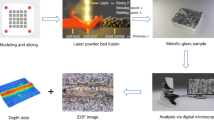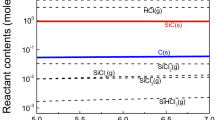Abstract
In the era of the Internet of Things, the demand for sensors—including those used in wearable devices, those used in smart machinery, electronic sensors for vehicles, and gas sensors—is steadily increasing. To improve the performance of sensing components, stacking circuits and packaging materials can be used as the heterogeneous chips in manufacturing processes. For example, owing to its composition of multiple materials, a sensing component cannot be returned to a semiconductor production line for a second round of the through-hole process. Because the laser is an excellent tool for via processes, the diffraction limit of a laser-focused spot should be considered. Thus, for holes with large diameters (i.e., 100 μm), composited laser machining should be considered. This study used 532-nm laser milling technology to fabricate holes with large diameters (300 μm) on a silicon-based glass heterogeneous integration composite material used in sensing components. Single-layer and multilayer milling removal rates, depth of focus formula, and experimental analysis results were recorded. The effect parameters were laser power, galvanometric scanning speed, and number of laser milling processes. The fabrication via characteristics were systematically analyzed using a field-emission scanning electron microscope, a confocal laser scanning microscope, and a four-point probe instrument. Moreover, to analyze the via performance after laser milling, a filled metal contact deposition process based on the resistance value measurement was employed. The experimental results revealed that (1) the diameters of the perforated holes increased with the number of laser milling processes, (2) the galvanometer scanning speed increased as the via diameter decreased, (3) the oxygen concentration distribution around the hole decreased farther away from the hole, (4) the inside of the hole contained high concentrations of carbon and oxygen because of the laser processing process, and (5) more laser residues were observed closer to the bottom of the hole, causing more material to adhere to the wall closer to the bottom. Finally, the side view revealed that as the number of laser milling processes increased, the hole could be dug deeper, and the sidewall of the hole became more vertical, resulting in the measurement angle decreasing relatively.













Similar content being viewed by others
References
Daniel GO, Pilar HF, Peres Henrique EM, Josue MG, Koiti A, Sergi GS, Gino P (2021) Silver enhances hematite nanoparticles based ethanol sensors and selectivity at room temperature. Sensors 21(2):440. https://doi.org/10.3390/s21020440
Xu JM, Cheng JP (2016) The advances of Co3O4 as gas sensing materials: a review. J Alloys and Compounds 686:753–768. https://doi.org/10.1016/j.jallcom.2016.06.086
Lin CS, Hsieh HF, Ding CF, Li KM, Young HT, Hsiao WT (2022) Laser surface modification on rGO/ZnO composite materials for NO2 gas sensing. J Mater Chem Phys 290:126551. https://doi.org/10.1016/j.matchemphys.2022.126551
Theuss H, Pressel K (2020) Handbook of Silicon Based MEMS Materials and Technologies (Third Edition), Oxford, UK, pp. 691–706
Fischer AC, Forsberg F, Lapisa M, Bleiker SJ, Stemme G, Roxhed N, Niklaus F (2015) Integrating MEMS and ICs. Microsyst Nanoeng 1(1):15005. https://doi.org/10.1038/micronano.2015.5
Motoyoshi M (2009) Through-silicon Via (TSV). Member IEEE 97(1):43–48. https://doi.org/10.1109/JPROC.2008.2007462
Lau JH (2011) Overview and outlook of through-silicon via (TSV) and 3D integrations. Microelectron Int 28(2):8–22. https://doi.org/10.1108/13565361111127304
Lee JY, Lee SW, Lee SK, Park JH (2013) Through-glass copper via using the glass reflow and seedless electroplating processes for wafer-level RF MEMS packaging. J Micromech Microeng 23(8):1–10. https://doi.org/10.1088/0960-1317/23/8/085012
Lueck M, Huffman A, Shorey A (2015) Through glass vias (TGV) and aspects of reliability, 2015 IEEE 65th Electronic Components and Technology Conference (ECTC): 672–677. https://doi.org/10.1109/ECTC.2015.7159664
Chen MF, Hsiao WT, Wang MC, Yang KY, Chen YF (2017) Multi-performance characterization analysis of diameter and taper angle on alumina ceramic via using pulsed ultraviolet laser percussion drilling method. Opt Quant Electron 49(11):383. https://doi.org/10.1007/s11082-017-1222-1
Chen MF, Hsiao WT, Wang MC, Yang KY, Chen YF (2015) A theoretical analysis and experimental verification of a laser drilling process for a ceramic substrate. Int J Adv Manuf Technol 81:1723–1732. https://doi.org/10.1007/s00170-015-7219-7
Tan B, Venkatakrishnan K (2007) Nd-YAG laser microvia drilling for interconnection application. J Micromech Microeng 17(8):1511–1517. https://doi.org/10.1088/0960-1317/17/8/013
Yang CC, Yang CC, Hsu CN, Huang KC, Tseng SF, Hsiao WT (2018) Multilayer stack materials on silicon-based wafer dicing processes using ultraviolet laser direct dicing and milling methods. Optics and Laser Tech 108:441–449. https://doi.org/10.1016/j.optlastec.2018.07.034
Hsiao WT, Tseng SF, Huang CK, Chen MF (2013) Effects of macro- and micro-hole milling parameters on Al2O3 ceramics using an ultraviolet laser system. Proc SPIE 8769:87693L. https://doi.org/10.1117/12.2018981
Yu Z, Hu J, Li K (2019) Investigating the multiple-pulse drilling on titanium alloy in picosecond laser. J Mater Process Technol 28:10–17. https://doi.org/10.1016/j.jmatprotec.2018.12.027
Shaheen ME, Gagnon JE, Fryer BJ (2013) Laser ablation of iron: a comparison between femtosecond and picosecond laser pulses. J Appl Phys 114: 083110. https://doi.org/10.1063/1.4819804
Zhang Z, Wang W, Jin C, Jiang R, Xiong Y, Zhang X, Mao Z (2021) Investigation on efficiency and quality for ultrashort pulsed laser ablation of nickel-based single crystal alloy DD6. J Adv Manuf Technol 114:883–897. https://doi.org/10.1007/s00170-021-06883-0
Tang Q, Wu C, Wu T (2021) Defocusing effect and energy absorption of plasma in picosecond laser drilling. Opt Commun 478:126410. https://doi.org/10.1016/j.optcom.2020.126410
Cristoforetti G, Lorenzetti G, Benedetti PA, Tognoni E, Legnaioli S, Palleschi V (2009) Effect of laser parameters on plasma shielding in single and double pulse configurations during the ablation of an aluminium target. J Phys D: Appl Phys 42:225207. https://doi.org/10.1088/0022-3727/42/22/225207
Acknowledgements
The authors would like to thank the Taiwan Instrument Research Institute Ms. Nancy Chu for supporting the use of high-resolution FE-SEM (Hitachi S-4300).
Funding
This work was financially supported by the National Science and Technology Council (NSTC) of Taiwan, with project numbers: 110–2622-E-492–016 and 109–2622-E-492–013.
Author information
Authors and Affiliations
Contributions
CS: conceptualization, validation, investigation, methodology, formal analysis. CH: validation, investigation, analysis. RJ: formal analysis, investigation, validation. KM: advisor, conceptualization, validation, investigation, writing—original draft. HT: advisor, resources, validation, investigation, writing—original draft. WT: methodology, supervision, validation, writing—original draft.
Corresponding authors
Ethics declarations
Conflict of interest
The authors declare no competing interests.
Additional information
Publisher's note
Springer Nature remains neutral with regard to jurisdictional claims in published maps and institutional affiliations.
Rights and permissions
Springer Nature or its licensor (e.g. a society or other partner) holds exclusive rights to this article under a publishing agreement with the author(s) or other rightsholder(s); author self-archiving of the accepted manuscript version of this article is solely governed by the terms of such publishing agreement and applicable law.
About this article
Cite this article
Lin, CS., Tai, CH., Chen, RJ. et al. Characterization analysis of 532 nm laser drilling of silicon-based glass heterogeneous integration composites. Int J Adv Manuf Technol 123, 3699–3710 (2022). https://doi.org/10.1007/s00170-022-10425-7
Received:
Accepted:
Published:
Issue Date:
DOI: https://doi.org/10.1007/s00170-022-10425-7




